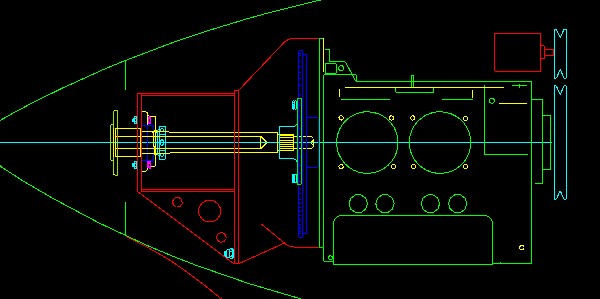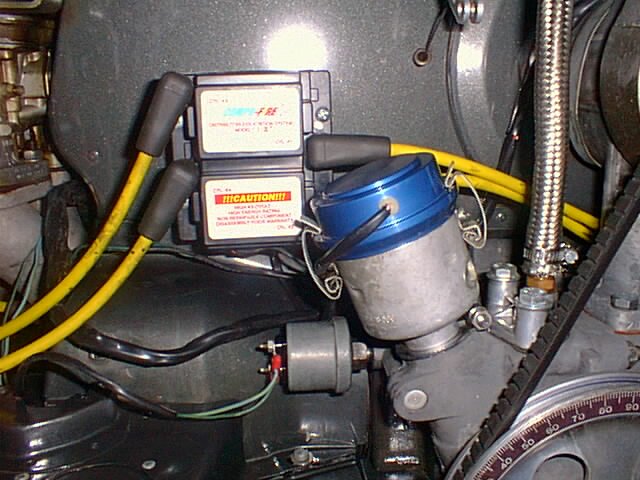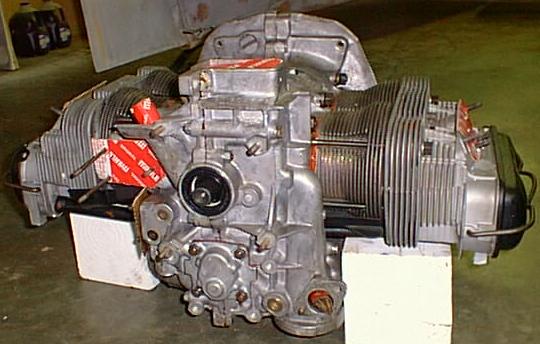
Originally written Jun 23, 1998

The Type 4 was VW's answer to the problems with the Type 1. Not that there was anything wrong with the original design, but over the years the horsepower that the Type 1 was asked to produce was more than doubled. Power requirements for the bus and 411/412 engine called for even more power. The Type 1's magnesium alloy case was simply too weak and thin (after boring) to withstand the kind of power output that we airplane builders would like to have.
The Type 4 case is a stronger aluminum alloy, and is thicker in critical areas. The case halves are joined using through bolts, rather than studs, which eliminates problems with threads pulling out. And the cylinder stud spacing allows plenty of room for cylinder size increases. On the Type 1, 94mm cylinders leave very little cylinder wall, leading to the possibility of distortion and cracking (although I've never experienced it). The Type 4's can easily go to 105mm cylinders. The Type 4 case has a reputation among VW engine shops as being very durable. The Type 1 almost always needs to be line bored at every rebuild. Line boring a Type 4 is rarely necessary due to the increased material strength and beefier construction.
The first VW powered planes were 36 hp models used in Volksplanes (and even earlier models). The low power requirement and the quest of keeping it simple and cheap led designers to simply bolt a prop hub in place of the generator pulley. As power output grew, crank problems developed. Excessive bending stress levels caused by propeller forces led to crank failures and prop hubs departing the airframe. The solution that was imposed was to simply make the crank indestructible by using 4340 steel and a large prop bearing. Unfortuantely, the price of the Scat 4340 Type 4 crank has climbed to over $1300 due to low production volumes. For the same reason (low production numbers) Type 4 parts are normally 2-3 times the price of Type 1 parts, even though the materials and configuration are the same. This reminds me of a Porsche 356 engine that I got a deal on while in Germany...the heads were very similar to the VW of the same displacement, but just different enough to be different. The prices difference was a factor of ten, with the Porsche part much more expensive. They call that "economy of scale"...the cost to tool up for cast heads is about the same, whether the result is 100,000 heads or 1,000 heads.
Now that the crank is indestructible, many of those same forces are still absorbed by the case. It's not uncommon to hear of Type 1 VW cases being replaced every 300 hours because the case is worn out or internally cracked (leading to oil pressure loss).

I decided several years ago that my VW powered airplane would run the prop off of the CORRECT end of the engine, the flywheel end. The standard VW flywheel is designed to dampen the power pulses of the engine and smooth them together, reducing the amplitude of torsional vibration. I've designed a drive shaft system which incorporates a thrust bearing mounted to a drive housing which is bolted to a Type 2 (bus) bellhousing. A similar system was used by Steve Wittman to win several Formula V races in the 1960's. One of the advantages of this system is that the long prop shaft allows significant cowling streamlining. Steve Bennett of Great Plains Aircraft is testing such a system this summer (1998), and expects to be marketing it at the end of the year.
One of the nice things about running the prop off of the flywheel end of the engine is that you now have the freedom to use a standard VW forged crankshaft. Hotrodders have been welding up the rod journals of stock cranks and turning them on larger centers to increase the stroke for decades. Don Demello is reputed to have developed the most robust version of the welded counterweighted VW stroker crankshaft, so I decided to go with his. His 78mm crank (71 mm is standard for the 76-81 2 liter) costs only $450. The limiting factor on stroke with the Type 4 is rod "big end" size. With increased stroke the big end of a stock rod will hit the camshaft and case, so special journals and rods are required as the stroke gets longer. The 78mm crank requires the use of VW 2.0 liter rods, which are fairly scarce and will set you back $250 a set. Going to 82mm stroke will force the use of aftermarket forged or billet rods which will easily cost $500 a set. And with more stroke, less of your original forged crankshaft remains after the crank grinding operation.
Given the above parameters, I decided to go with the 78mm stroke Demello crank, and stay a little conservative with cylinder size and use 103mm JSC pistons and cylinders. This translates to 2600 cc. I'm using stock (balanced, shotpeened, etc) VW 2.0 liter rods.
The camshaft required for aircraft use is very similar to the stock cam. The horsepower peak for the stock cam is around 4000 rpm, with a torque band from about 2000-4000 rpm. Because I'm using far more displacement, I'll need higher lift to open the valves up for more flow at 3600 rpm. Slightly larger valves might also help, but are almost certainly not worth the cost or effort, unless you have bad seats or seat retention, and need to redo them anyway. But duration needs to stay almost stock, since that's what determines your powerband. It doesn't do any good to slap a racing cam in if your power peak is now at 5000 rpm, because you can't get there with a 54" prop without self destruction. And moving your powerband up means less power on the low end where you need it. I'm hoping for 3800 rpm.
I also wanted a set of heads rebuilt by Mark Stephens High Performance. Their heads have been featured in several of the VW hot rod magazines are are reputed to have improved combustion properties which allow higher compression ratios to be run without detonation. They call it "zero clearance", so I suspect they mean that they have minimized the quench area of the combustion chamber to near zero in order to eliminate "end gas" that can cause detonation with low octane fuels or high compression ratios. They also do a better job of shrink fitting the valve seats into the head. Dropped valve seats are a common malady of Type 4 heads due to inadequate interference fit from the factory. These heads with big valves and port and polish job (which won't help us much at 3800 rpm!) run about $1000 a pair. I'm using one size larger than stock valves.
I called and asked about these heads, and in the discussion was asked what I was building this engine for. I told them "an airboat", and the guy said "oh, we build those all the time". It turns out that I can buy the engine that I had planned to build for $2995. Clearanced, balanced, test run (on video tape) and delivered to my door. $400 for core charge, $200 shipping to Alabama from California. $3600 and I'm ready to hang it on the plane. As much as I wanted to build that engine, I couldn't see any way to keep from buying it. The classic no-brainer. I'll still tear it down before I fly it just to see what's inside, but it's exactly what I'd decided to build myself, right down to the Demello crank. It even has their "P-1" cam, a Webcam 111 camshaft with almost stock duration but higher lift for this "prop" application. That's 238 degrees of duration measured at .050" and .476" of lift. They've dynoed this exact engine configuration at 115 hp at 3500 rpm running dual 40 mm carburetors (it would probably be better with one, at this rpm) and pulling a stock fan. Torque is 165 lb-ft in the range from 2000-4000 rpm. You can't argue with those kinds of numbers, and they are in line with dyno tests on engines by Kawell and FAT that have been featured in Hot VWs magazine in recent years. And they've built several of these with different cam and valve size combinations. They've settled on the combination that I'd already decided to go with, and that's what I bought. Mark Stephens High Performance WAS located at 21800 Oak Summit Ct., Tehachapi, CA 93561, ph (805) 822-5678, but has since gone out of business. It's not that they didn't do good work or have a great reputation, but they overextended themselves in development of a new 6 stud per cylinder head application, and never recovered financially.

I'm planning to use a Compufire ignition system. This is a Bosch 009 distributor with a magnetically triggered igntion module firing separate coils. Each spark plug has it's own coil. I've been testing this setup in my 2110cc Karmann Ghia for years, and it has worked flawlessly. I don't plan to use a magneto. In all the years of driving VW's I've never had a sudden ignition failure. I don't expect one in my airplane either.
I WAS planning to use Bosch CIS fuel injection from an early Rabbit. This system is purely mechanical, with only the fuel pump being electrical. The cold start valve is also electrical, but is not mandatory to stay aloft. The beauty of this system is that it is icing free, altitude compensating (somewhat), and requires no primer. That's two controls (mixture and carb heat) that I don't have to worry about while I'm busy trying to fly the plane. Another plus is price. The junkyards are full of them and they're cheap. They come with stainless steel aircraft quality fuel lines (I'll buy all new ones) as well. The only minus is that the fuel is pressurized to about 70 psi, but I've never seen a failure there either. The displacement capacity of this injection system is almost perfectly matched to the 2600 cc engine running at 3800 rpm. This system is dirt simple, and you'll rarely hear of a Rabbit owner who's not happy with it, or ever had to repair it.

I got the engine in late June of 1998, along with the video of the test run. The video has my engine on the test stand, along with oil temperature, oil pressure, and tachometer mounted above and on-screen. It is run several times, and the tester gives a running narration on the care and feeding (what kind of oil, breakin details, etc) of my particular combination. I'm impressed, to say the least!
Revised August 99
The bad news for you VW fans is that I've discovered the Corvair engine. Yes, I've gone to the other side, despite being a staunch VW man since childhood! The possiblity of 135 hp from an inexpensive 240 pound proven bulletproof 6 cylinder was too hard to resist. I'm now in the process of rebuilding a Corvair for my KR2S. My Type 4 would have been at least 225 pounds, after adding the prop drive shaft. And there was something about testing: 1) a new airframe with many aero mods, 2) A new Type 4 engine, 3) A radical CIS fuel injection system, and 4) A radical shaft drive setup, that didn't really appeal to me. Maybe after the airframe is tested I'll add CIS to the Corvair, and then maybe I'll put the Type 4 in. But why? Especially if I get my 140 hp. 100 hp is not uncommon from a stock 110 hp running at 3200 rpm, and I'm boring mine out to 3100 cc, an increase of 15%. I also plan to run my 54" wooden prop at 3800 rpm (full throttle) so that'll be another 19% increase, which adds up to 138 hp. I plan to use a fairly awesome intake system with a Weber 40DCOE dual throat side draft carburetor, which will gain me even more. See more details of my Corvair's "desktop dyno" figures at my Corvair specs page. I've sold my Type 4 to a guy in Colorado..
Return to KR2S Construction.